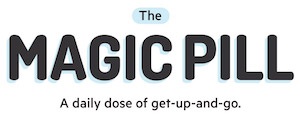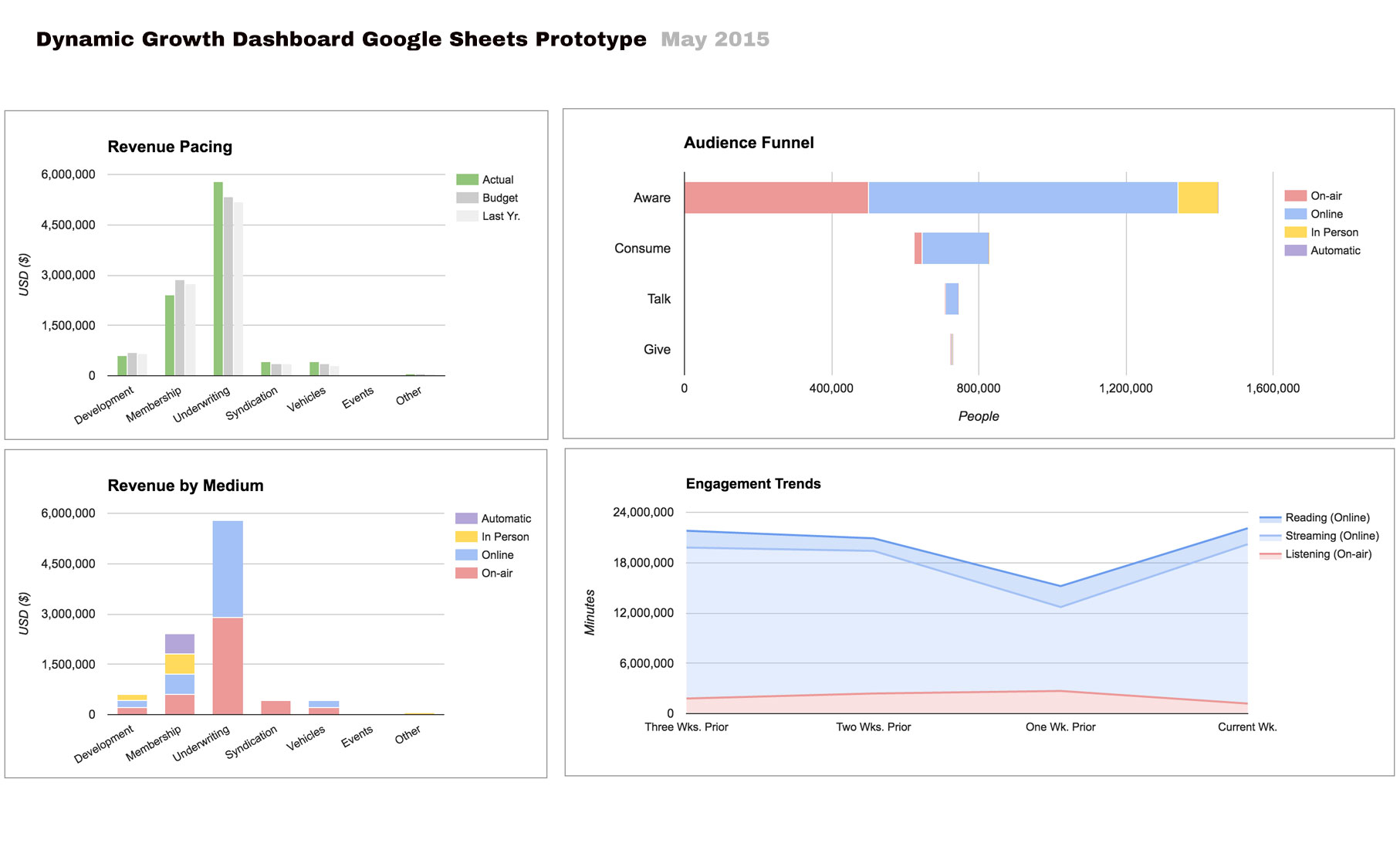
Last year, Carey Goldberg, the editor of Boston public radio station WBUR’s health blog CommonHealth, put together four pilot episodes of an exercise podcast.
“Exercise is good for every organ, it lowers the risk of every disease,” Goldberg told me, and she thought that she could encourage listeners to work out by helping them understand the benefits of exercise. Still, the podcast “got kind of yellow-lighted. We produced a pilot series of four, and it seemed promising, but we hadn’t quite figured out whether to go forward with it and what we should do with it.”
While Goldberg’s semi-produced podcast was languishing, another effort was getting off the ground at WBUR: Public Radio BizLab, a standalone team within the station with a mandate to try and develop new models for public media to make money and reach audiences.
The BizLab team was looking for projects to begin its experiments with, and with Goldberg’s podcast going unused, they together decided to use it as an opportunity to try something new.
 As a result, the podcast, called The Magic Pill, is launching today, cohosted by Goldberg and Harvard Medical School professor Eddie Phillips. WBUR launched a pilot of the podcast earlier this summer, but the saying goes that it takes 21 days for people to develop new habits, so WBUR will be releasing episodes of the podcast daily over the next three weeks to help listeners get in the practice of exercising.
As a result, the podcast, called The Magic Pill, is launching today, cohosted by Goldberg and Harvard Medical School professor Eddie Phillips. WBUR launched a pilot of the podcast earlier this summer, but the saying goes that it takes 21 days for people to develop new habits, so WBUR will be releasing episodes of the podcast daily over the next three weeks to help listeners get in the practice of exercising.
“They decided to use what was at that time was this half-baked product and to bring it to fruition to experiment with some of the lines they were working on as well,” Goldberg said.
Several of BizLab’s experiments are coming together around The Magic Pill. The podcast was developed using a Learning Plan, a planning tool BizLab created to map out new projects. Each episode of the podcast will feature a song from a blockchain music library that BizLab developed in partnership with researchers at the Berklee College of Music. And WBUR is using the podcast to test out its Dynamic Growth Dashboard, a custom-built web app that highlights metrics from across the station.
The results of all of BizLab’s experiments will be shared publicly, and it plans to help other public media outlets learn from its projects, BizLab executive director Meg Siegal told me in an interview at the Public Media Development and Marketing Conference in Boston last month.
“WBUR is like a Petri dish, and the ones we think will help other people, we’ll share,” she said. “The ones didn’t go well, we’ll still report on them.”
“We decided that while we were healthy and thriving was exactly the time when we should invest in a significant effort to explore outside of our revenue models, and bring together a team of people who would look at the big questions about what will be the major business model changes that will need to be embraced in the coming years.”
WBUR received a $250,000 grant to support BizLab from the Knight Foundation. (Knight also supports Nieman Lab.) The station also kicked in $250,000 from its own budget, and it’s raised another $750,000 from other sources. In all, BizLab has raised $1.25 million so far; the station’s goal is $5 million to fund the lab for five years and bring in additional staffers to help further its work.
Meg Siegal’s background is in advertising, and she joined WBUR last year to run BizLab. She works with Lisa Williams, who is BizLab’s engagement director.
BizLab’s first goal, Siegal said, was “to just start to look at how the organization in different departments was conducting research on its listeners, and what we knew about them.” Siegal worked with the design consulting firm IDEO for a two-week project that tried to identify different listener types and opportunity areas for WBUR. They did one-on-one interviews with about 20 listeners to ascertain how they consumed the station’s coverage and what they’d like to see from WBUR.
BizLab and Ideo then created five listener types that modeled the different ways WBUR’s listenership interacts with its programming and coverage, presenting them as animals. Dolphins are obsessed with public radio as a whole; lions feel a strong connection to WBUR specifically; flamingos “hunt and peck” depending on stories they’re interested in; collies are loyal to particular programs; turtles are listeners who are in long-term relationships with WBUR and public radio.
The report that emerged from the IDEO project highlighted different ways WBUR could connect with each group, but one of the main takeaways was that listeners across groups were interested in content that would “help me decompress, help me find time for self-care,” Siegal said.
“After we had that insight from talking with people, we then went back to the station and started to look what potentially existing assets and resources are there that we can fulfill this need that the audience has,” she said.
That’s how BizLab took on The Magic Pill as a project. Siegal’s team was working on a number of other efforts simultaneously, and it was then able to apply those to developing the podcast.
They built the Learning Plan, for instance, because they couldn’t find a business modeling map that was really well suited for public media, where members and user retention is at the core of everything stations do.
The Learning Plan starts with a major research question. For The Magic Pill, WBUR asked: Are listeners who take action on content in a way that changes behavior more likely to donate or become members?
Staffers then plan out the opportunities and costs for content delivery, asset usage, targeted users, participating stakeholders, the business model, the definition of the experiment, and how it will be measured. For The Magic Pill, WBUR decided to distribute each day’s podcast episode via email instead of more traditional podcast channels. (You won’t find The Magic Pill in iTunes or your favorite podcast app.) It outlined that the cost of email distribution would be $75 per month for MailChimp.
The plan then lays out which type of users the product hopes to target. In the case of The Magic Pill, WBUR wants to provide its present listenership with an interesting podcast experience, but it also wants to attract new listeners and new members. The Learning Plan estimates that it will target about 2,200 members and a new audience of 50,000 people.
The business model section of the plan then described the email as one of the ways the station hopes to attract members with The Magic Pill. Answering the question, “Why would they pay?” the plan said because Magic Pill helped them feel “more hopeful about having daily fitness as a regular component of their life, and their contribution would make future CommonHealth productions possible.” They set goals for contributions of $10 to $120 per donor.
And because email is a pillar of The Magic Pill’s distribution strategy, they can then target specific audiences for contributions. Siegal said BizLab has worked with behavioral economists from the Harvard Business School about devising strategies for the best way to ask for money.
“If you’re not local, we’re not going to ask you to be a member,” she said. “We’re going to ask you if you want to buy an ebook that we have, 50 More Magic Pills, from content that Carey already wrote on the website. Or do you want to help Season 2, or to help more stuff.”
According to the effect section of the Learning Plan, 9,325 users had visited the Magic Pill’s landing page through Aug 31, and 4,383 of those users had signed up for the email. That section also sets out the team’s hypotheses for many of the metrics: They expect 1,250 people to visit The Magic Pill’s donation page, and they think 125 of those will become one-time donors and another 125 will become monthly sustainers.
Another key aspect of the learning plan is the effect measurement. BizLab is trying to establish a common set of metrics so staffers across WBUR have an understanding of what they’re trying to achieve and how to measure success.
That’s the thinking behind the Dynamic Growth Dashboard, the custom metrics system BizLab developed in partnership with Johanna Brewer, a developer and inventor with a Ph.D in information and computer science.
Much of the challenge of bringing more data into organizations’ operations is coordinating employees and making sure they understand what information they need and the most useful ways for them to measure and use it. Brewer interviewed 23 upper and middle managers from across the station to do an anthropological study of sorts; that led to a 15-page ethnographic report that detailed the state of the organization, how it communicates, and how it uses data to accomplish its tasks.
The second phase of the project was what Brewer called “an operations upgrade.” WBUR has regular managers’ meetings, and Brewer and Siegel took over one of those weekly meetings for a few weeks to discuss how they used data. They came up with a list of 180 metrics from across the station that they followed. Brewer then built a prototype and did some participatory design work with the managers to try and improve the product.
The third phase was the creation of the dashboard. “I don’t like to build stuff if I don’t have to, I like to just go shop in the marketplace and pick one out. But, as I looked around and saw some of the other initiative inside public media and outside public media, there really wasn’t anything really fit to what we wanted to do,” Brewer said.
WBUR wanted a tool that was accessible to everyone throughout the organization and ensured that staffers across departments were using data that was measured in the same way. Currently, many of these metrics are measured on a desk-to-desk or department-to-department basis, and there’s no centralized place to find the information.
“If we’re going to answer ‘number of users doing X,’ we need to always measure that in the same way,” Brewer said. “If you’re in that department and I’m in this department, we need to be using the same measuring tool, and it needs to be a scientific thing where if Jane or Joe measures it, they come up with the same answer because it’s science. This notion wasn’t controversial, but it was sort of a surprise to some people in the organization. A lot of what the dashboard does is it’s a shared artifact that encodes this information.”

The dashboard includes automated metrics such as web traffic stats, but other more bespoke datasets specific to the station are often collected and input into the system manually.
A challenge for Brewer was to figure out the best way to measure all that manually entered data, because different department kept their records based on different days. That can make it difficult for managers to make cross-departmental apples-to-apples comparisons.
“I had to do some interesting math work — nothing big, but it was non-trivial — to actually come up with an algorithm to solve that, but I did. And it’s really exciting, because once I implemented being able to see one department’s data that reports on Mondays, another department’s data that reports on Fridays, and lets say the GM wants to get a complicated comparison of that every Wednesday. Can we do it? Can it be cogent? And the answer is yes.”
Each metric has an “owner” responsible for that specific piece of data and detailing how specifically it is calculated. However, other dasboard users have access to the information and can create their own reports to suit their needs.
“Let’s say that we’re going to talk about Twitter followers for On Point,” the station’s nationally syndicated morning talkshow, Brewer said. “That’s one thing that we want to pay attention to. The way that we’re going to track that is going to be determined by the producer of the program. In the dashboard, her face is next to that metric, and it says how she gets it. There’s a space for her to write in how she’s computing this information — if she’s entering it manually or if it’s being entered automatically because you set up some hook, and it’ll say what service it’s speaking to and where it’s querying that number from. But it encodes it to say one person is responsible ultimately for getting it and monitoring it, and that person needs to explain exactly how it’s done.”
The dashboard is a responsive web app, and WBUR plans to make the code public so other outlets can use it as well.
WBUR plans to roll out access to the dashboard to staffers, and also to project it on screens around the station.
“We want to test it at WBUR, but then work with funders to help us white-label it and scale it to other organizations for free,” Siegal said. “The idea is that we can make this software so that another station can pick it up and customize it for themselves, because it would be so interesting to see if there was a way to have a view into the health of the public media system, and a view into the results from varying experiments that stations are doing.”
The Magic Pill podcast will also include songs from a blockchain music library that it built with a team from the Berklee College of Music. The library will allow WBUR to try out a new technology while also enabling it to bring new people into the public radio fold.
Blockchain is the same technology that the currency bitcoin is built on. Blockchain is essentially a public, uneditable, ledger that records whenever a file is accessed or transferred.
Users shouldn’t notice any difference in how they consume the music, but artists and producers will have more detailed data about how the songs are being used, said George Howard, a professor at Berklee and a music industry and technology veteran.
“Using blockchain tech, we’re able to track the usages of that music in a much more efficient way and, importantly, provide information data to all the stakeholders. To a musician, you might get a report saying: Hey, your music was used on this date, at this time, downloaded by this person at this time, etc. etc. For a listener, they might say: Hey, I like this music I would like to access it more frequently, and I’d like to pay for it. We can track that payment and fragmentally distribute that payment to WBUR, NPR, or the artist.”
BizLab worked with a company called Revelator to build the blockchain music library. The library is an early-stage prototype and includes a couple hundred songs mostly from local Boston artists.
But Howard said blockchain could ultimately make it easier for radio producers and podcasters to ensure that they have the proper rights for music they want to broadcast and allow them to use tunes from up-and-coming artists.
Blockchain could also give podcast or radio producers more detailed data about the music they’re using in their shows. For example, Howard said producers could look at the data to see whether podcasts are downloaded or shared more with a certain type of music in them. Public radio stations could also take a collection of songs and sell them to listeners as a fundraiser.
“Blockchain should be completely transparent. There’s a front end where [producers] don’t need to know that these songs are registered on an immutable ledger that’s distributed,” he said. “They don’t care. Nor should they. It’s the additional functionality [that’s important.]”
These are still early days for BizLab. The Magic Pill and the projects currently launching around it are really the first projects to reach an audience after a year or so of research, planning, and development.
“This is a very exciting point in the growth of BizLab, in that this is really the first outward-facing, show-don’t-tell project of BizLab,” said John Davidow, WBUR’s managing director of digital. “It’s been gearing up toward this point.”
BizLab hopes to introduce a total of 10 experiments this year. This fall, Siegal said the lab is planning on working with the membership team to use the tools they’ve developed to look at new ways to engage with members.
Another tool in the works for BizLab is Bench, which would like to make it easier for producers to combine content, user engagement, and calls to action. Siegal and Williams have worked up a Learning Plan for the project, but they need more funding to get it underway.
WBUR is in the process of seeking out funding sources, including individual donors, grants, and more. Kravetz, the general manager, said BizLab would ultimately like to hire more people with background in technology, behavioral analytics, and other areas to help expand the focus of the experimentation.
“We’re very excited about the things we’re working on,” Kravetz said. “And we’re hopeful that even though this is kind of a big-ass idea, that out of it will come very few — even one — great big-ass idea that would be a breakthrough.”